Linda Lam
Christmas is getting closer and hopes of snow blanketing the landscape for the holiday are growing. Winter Storm Elliott along with arctic cold will likely bring a white Christmas to areas that haven't seen one over the past couple of years.
In meteorology, a white Christmas occurs when there is at least 1 inch of snow on the ground on Christmas morning. It doesn't have to be snowing on the holiday for that to happen.
White Christmas 2022 Forecast
The best chances for an inch of snow blanketing the ground on Christmas morning is in the higher elevations of the West and from the Northern Plains and Midwest into the eastern Great Lakes and portions of the interior Northeast. However, areas from the southern Appalachians into the Ohio Valley and Central Plains could also see a white Christmas.
Winter Storm Elliott has brought snow to many of these areas over the last couple of days and any snow that falls this week will not melt before Christmas due to the cold blast associated with the storm.

How Typical Is A White Christmas?
The map below shows the locations with a historical chance of a white Christmas in any given year. The chances are based on averages from 1991 to 2020.
There isn't much territory outside the Mountain West, the far northern tier and northern New England where the odds of a white Christmas are higher than 50%.
 Historical chance of a white Christmas in any given year, based on 1991-2020 data from NOAA.
Historical chance of a white Christmas in any given year, based on 1991-2020 data from NOAA.The last few years are good examples of how limited snow cover can be on Christmas morning.
Christmas 2021 had the third-lowest snow cover in the Lower 48 in the last 10 years, with just 26.6% of the contiguous U.S experiencing a white Christmas. Snow cover was only found in the West and across the far northern tier. This is not surprising given how December 2021 was the warmest December on record.
Christmas 2020 had the second-least-expansive Christmas snow cover since 2012, with just 26.5% of the Lower 48 covered in snow. That snow cover did extend farther south than typically is expected into the southern Appalachians.
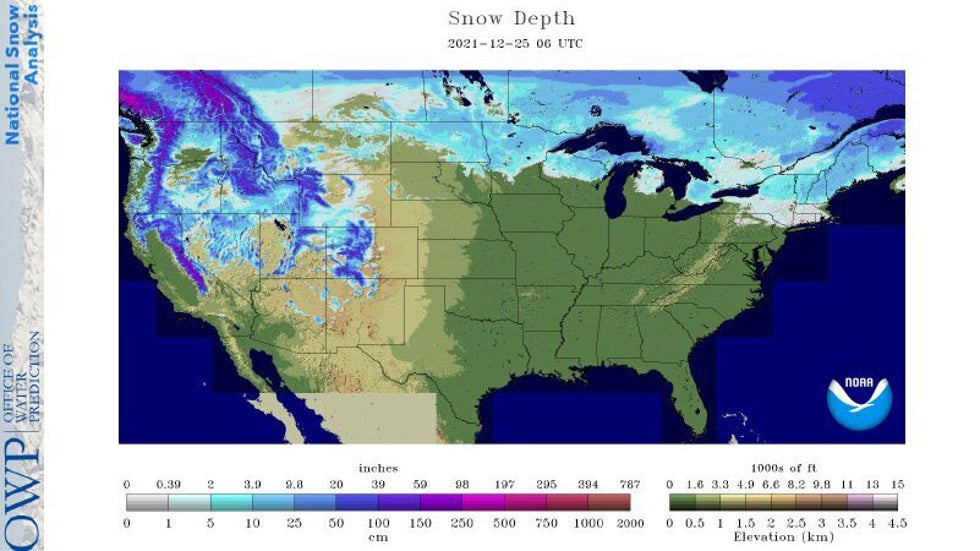 Snow cover on Dec. 25, 2021.
Snow cover on Dec. 25, 2021.Almost half of the U.S. had snow on the ground on Christmas morning in 2017. That year, snow covered the northern tier as expected and reached portions of the Central Plains, Midwest and Northeast.
On average, about 37% of the Lower 48 has snow on the ground on Christmas, according to 19 years of data compiled by the NOHRSC. Since 2003, those percentages have varied widely from year to year, from 21% in 2003 to a whopping 63% of the contiguous U.S. in 2009.
Regional Historical Odds
Below we break down various white Christmas statistics, including the yearly probability, the number of white Christmases in each city's historical record and the last white Christmas.
The annual probability is based on data from the National Weather Service from 1991-2020.
Northeast
The most snow on the ground in Albany (1966) and Buffalo, New York (2001), on Christmas morning, was 19 inches. New York City has seen up to 8 inches on the ground on Christmas (in 1912), and 7 inches is the top Christmas snow depth in Washington D.C. (2009).
Last Christmas, Albany and Syracuse had an inch of snow on the ground Christmas morning, making it an official white Christmas.
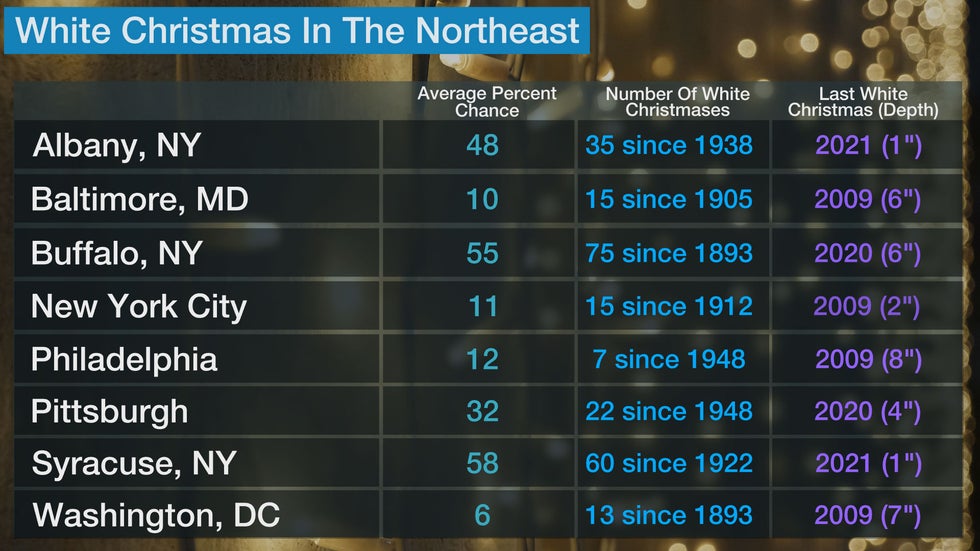
Burlington, Vermont, and Caribou, Maine, have had more than 30 inches of snow on the ground in Christmases past. In 2021, both locations experienced a white Christmas with 8 inches of snow on the ground in Caribou and 4 inches of snow measured in Burlington, where it even snowed a trace on Christmas day.
The record snow depth in Boston on Christmas morning is 11 inches (1995). Concord, New Hampshire, has measured up to 26 inches on the ground (1970). Last Christmas, Boston didn't have snow, but Concord had 6 inches. Providence reported 2 inches, with a trace of snow falling on Christmas.
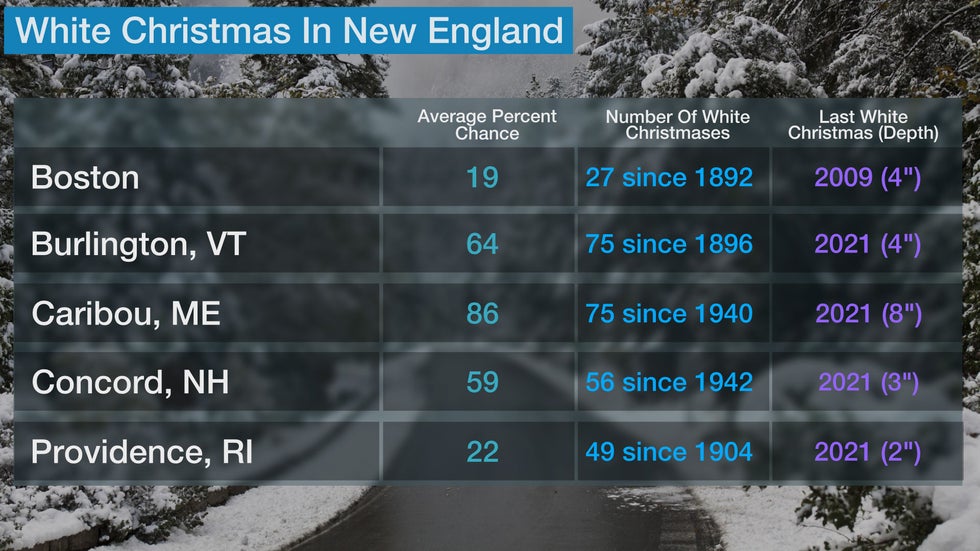
Midwest
Milwaukee has a top snow depth record of 25 inches (2000). Chicago's record is 17 inches (1951). The last white Christmas for both cities was in 2017. The last white Christmas in Cleveland (7 inches) and Detroit (an inch) was in 2020.
Most of the region didn't see a white Christmas last year because the snow was confined to the northern Great Lakes. Marquette, Michigan, observed 5 inches of snow on the ground with a trace of snow falling on Christmas.
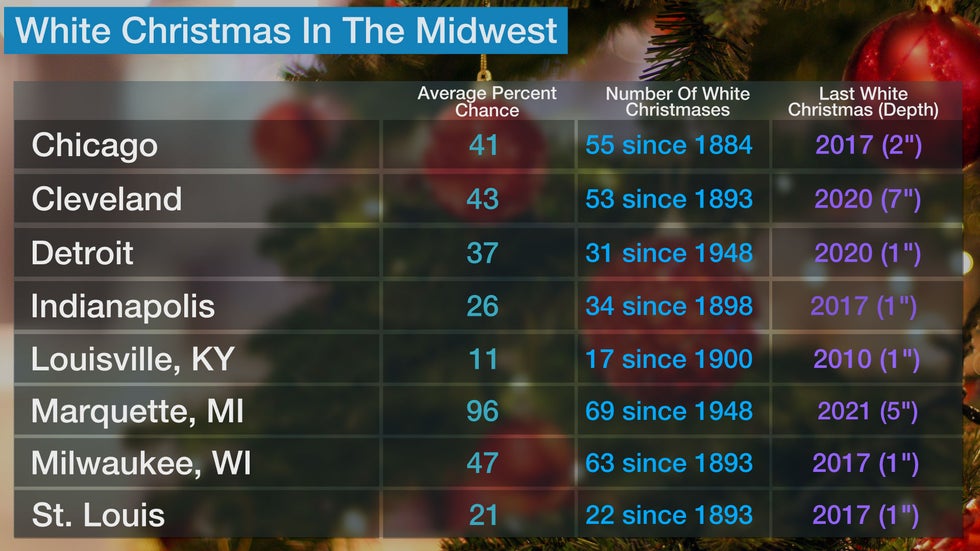
Plains
Duluth, Minnesota, and Pierre, South Dakota, have had more than 2 feet of snow on the ground on Christmas. There was no white Christmas in Pierre last year, but Duluth experienced a white Christmas with an inch on the ground. The record in Wichita, Kansas, is 4 inches (2007). The last white Christmas there was in 2013.
In 2020, Minneapolis measured 8 inches of snow on the ground on Christmas morning. Des Moines, Iowa, and Omaha, Nebraska, also had a white Christmas in 2020.
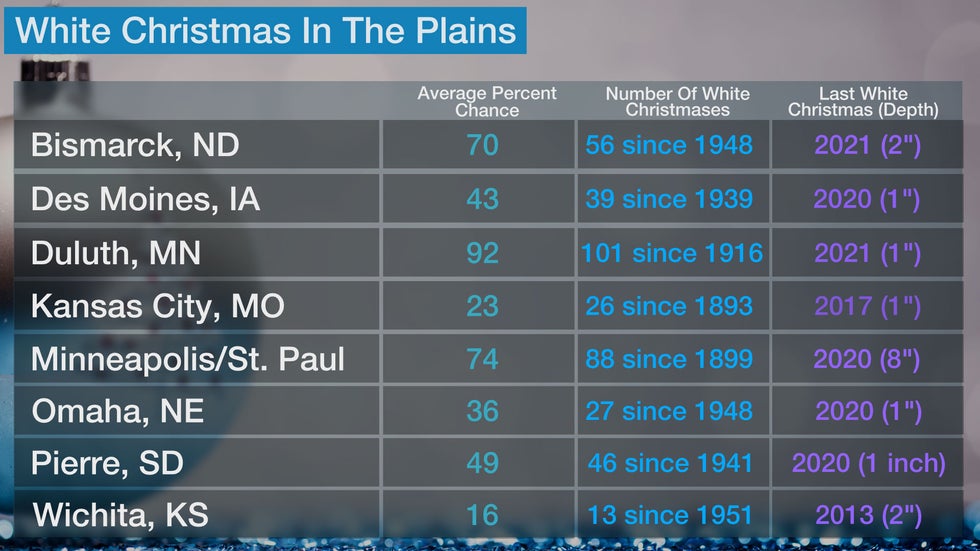
West
The highest snow depth on Christmas morning in Tahoe City, California, is 52 inches (1970). Denver's record is 2 feet (1982). No snow was on the ground the past four Christmases in Denver, but Tahoe City had 31 inches last Christmas.
Five years ago, Seattle and Portland both experienced their sixth white Christmases on record. Seattle had 2 inches of snow that Christmas morning.
In Alaska, Anchorage and Fairbanks unsurprisingly both saw a white Christmas last year, with 13 inches and 21 inches on the ground, respectively.
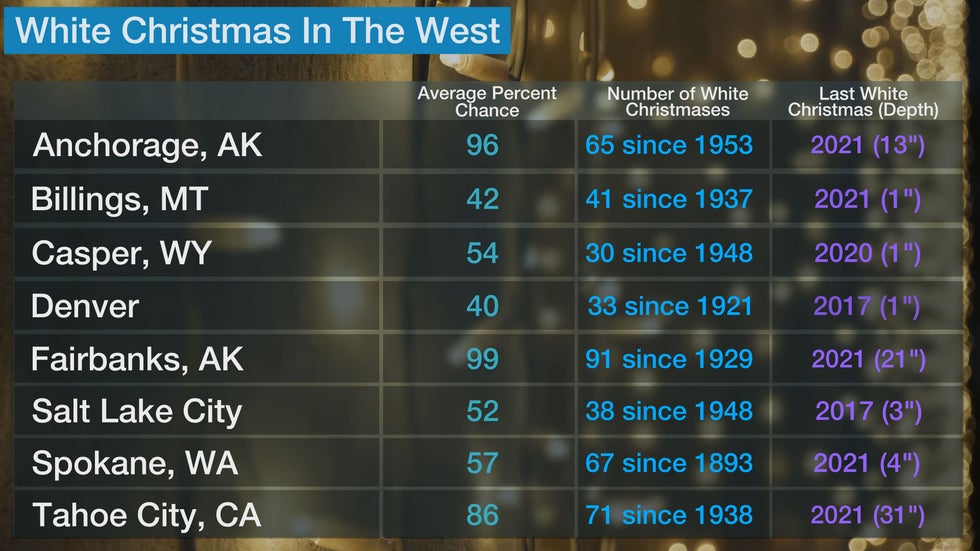
Yes, It Has Happened in the South
Christmas snow cover isn't just a northern thing. Some years, parts of the southern U.S. have marveled at the sight of a white Christmas. But it's been more than 10 years since a white Christmas was observed in most of the South.
The greatest Christmas snow depth in both Memphis (10 inches) and Nashville, Tennessee (6 inches), happened in 1963.
In 2020, a white Christmas was observed in Knoxville, Tennessee, (2 inches) and Roanoke, Virginia (1 inch). Nashville had a trace of snow on Christmas Day in 2020. Farther west, Tulsa, Oklahoma, received a trace of snow in 2017.
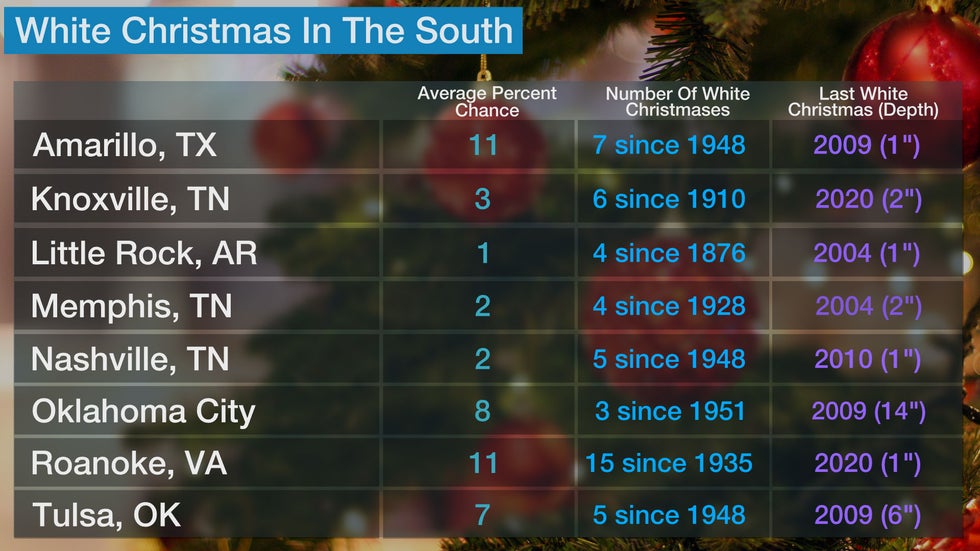
Three relatively recent events brought an unusual Christmas Day snow cover to parts of the South:
-In 2009, Oklahoma City had a snowstorm of record (13.5 inches) and one of only two white Christmases on record occurred in Dallas (2 inches).
-In 2004 in Texas, Corpus Christi had a record snowstorm (4.4 inches), and Brownsville (1.5 inches) had its first day of measurable snow since 1895. Brownsville is on the same latitude as Miami, Florida.
-In 1989, a pre-Christmas snowfall was followed by a strong arctic cold outbreak that brought both Charleston, South Carolina (4 inches), and Savannah, Georgia (2 inches), their only white Christmases. Jacksonville, Florida, missed a white Christmas by a day when an inch of snow fell Christmas Eve morning. It had melted by Christmas Day.
The Weather Company’s primary journalistic mission is to report on breaking weather news, the environment and the importance of science to our lives. This story does not necessarily represent the position of our parent company, IBM.
The Weather Company’s primary journalistic mission is to report on breaking weather news, the environment and the importance of science to our lives. This story does not necessarily represent the position of our parent company, IBM.

No comments:
Post a Comment